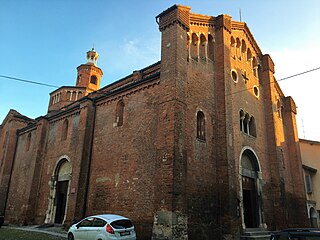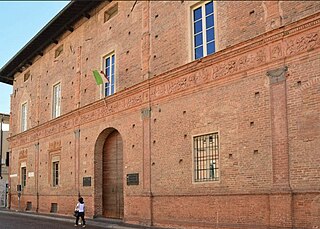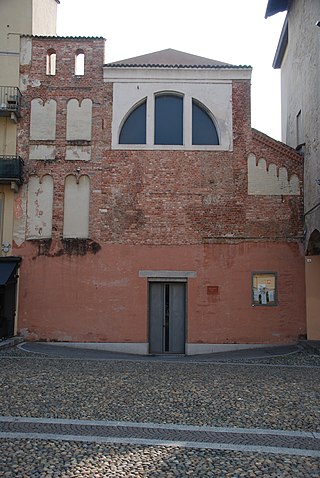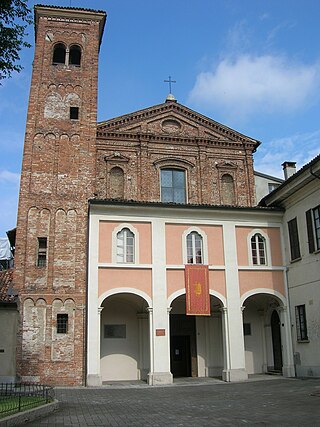
The Certosa di Pavia is a monastery complex in Lombardy, Northern Italy, situated near a small village of the same name in the Province of Pavia, 8 km (5.0 mi) north of Pavia. Built from 1396 to 1495, it was once located at the end of the Visconti Park a large hunting park and pleasure ground belonging to the Visconti dukes of Milan, of which today only scattered parts remain. It is one of the largest monasteries in Italy.

San Pietro in Ciel d'Oro is a Catholic basilica of the Augustinians in Pavia, Italy, in the Lombardy region. Its name refers to the mosaics of gold leaf behind glass tesserae that decorate the ceiling of the apse. The plain exterior is of brick, with sandstone quoins and window framing. The paving of the church floor is now lower than the modern street level of Piazza San Pietro in Ciel d'Oro, which lies before its façade.

Ansa or Ansia was a Queen of the Lombards by marriage to Desiderius (756–774), King of the Lombards.

Santa Maria del Carmine is a church in Pavia, Lombardy, northern Italy, considered amongst the best examples of Lombard Gothic architecture. It was begun in 1374 by Gian Galeazzo Visconti, Duke of Milan, on a project attributed to Bernardo da Venezia. The construction followed a slow pace, and was restarted in 1432, being finished in 1461.

The Civic Museums of Pavia are a number of museums in Pavia, Lombardy, northern Italy. They are housed in the Castello Visconteo, or Visconti Castle, built in 1360 by Galeazzo II Visconti, soon after taking the city, a free city-state until then. The credited architect is Bartolino da Novara. The castle used to be the main residence of the Visconti family, while the political capital of the state was Milan. North of the castle a wide park was enclosed, also including the Certosa of Pavia, founded 1396 according to a vow of Gian Galeazzo Visconti, meant to be a sort of private chapel of the Visconti dynasty. The Battle of Pavia (1525), climax of the Italian Wars, took place inside the castle park.

San Teodoro is a Romanesque-style Roman Catholic church in the town center of Pavia, Italy.

The Plutei of Theodota are two mid 8th-century Lombard marble bas-reliefs or plutei from the oratory of San Michele alla Pusterla in Italy. They are now held in the Civic Museums of Pavia. Naturalistic in style, they were produced during the Liutprandean Renaissance. One shows the Tree of Life between two griffins and the other shows a cross and font between two peacocks.
Theodota was a Byzantine noblewoman, most notable for her association with the Lombard king Cunipert (688–700). The Plutei of Theodota are named after her.

San Lanfranco is a Romanesque-style Catholic church and former abbey, located on via San Lanfranco Vescovo, 4/6, just west of the town center of Pavia, region of Lombardy, Italy.

The Basilica of Santissimo Salvatore is a Roman Catholic church in Pavia, region of Lombardy, Italy. It was founded in 657 by the Lombard king Aripert I and became a mausoleum for many of the Lombard kings.

The Monastery of San Felice was one of the main female Benedictine monasteries of Pavia. Founded during the Lombard period, it was suppressed in the 18th century. Part of the church and the crypt survive from the original Lombard complex.

The church of San Marino is a Catholic church in Pavia, in Lombardy.

Palazzo Mezzabarba is a palace in Pavia, Lombardy, a notable example of Lombard rococo. It has served as Pavia's city hall since 1875.

The Church of San Tommaso is a former Catholic church and monastery in the city of Pavia, Lombardy, Italy. It is located within the historic city center and belongs to the University of Pavia.

Palazzo Cornazzani is a palace in Pavia, in Lombardy, where, between 1895 and 1896, Albert Einstein lived.

Palace Carminali Bottigella is a noble palace built by the ancient Beccaria family from Pavia. The original structure from the Sforza era was built between 1490 and 1499. The façade, which retains the original terracotta decorations, is one of the major examples of Renaissance civil building in Pavia.

The church Santa Maria Gualtieri is a deconsecrated church in Pavia now used for exhibitions, concerts and conferences.

The Church of San Lazzaro is located on the eastern suburbs of Pavia. Built in the 12th century along the Via Francigena, it was equipped with a hospital dedicated to the care of pilgrims and lepers.

The Church of Santi Gervasio e Protasio is a church in Pavia, in Lombardy.

The Church of San Pietro in Verzolo is located on the eastern outskirts of Pavia, Italy, along the Via Francigena.

























